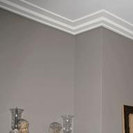Uses and benefits of coving
Coving sets off a room with an elegant finishing touch. Found widely on properties during the Victorian, Georgian and art deco periods, cornice and coving has its roots in classical architecture. It continues to be a popular choice in interior design and is specified for modern commercial premises and homes – even working well with a bold, minimalist scheme.
Originally made from plaster, coving and decorative cornice is now available in lightweight, composite alternatives as well as fibrous plaster. A huge choice of styles is available to achieve anything from an understated to extravagant look. Coving plays an important decorative role, smoothing the colour progression from wall to ceiling.
Plaster coving or cornice is often combined with ornate plaster ceiling roses or other decorative features in period homes. There are specialist firms that will make bespoke coving for restoration work.
Coving made from hardened polyurethane or polymer has many benefits, including its light weight and the ability to be bent round curves and use in humid areas such as bathrooms.





